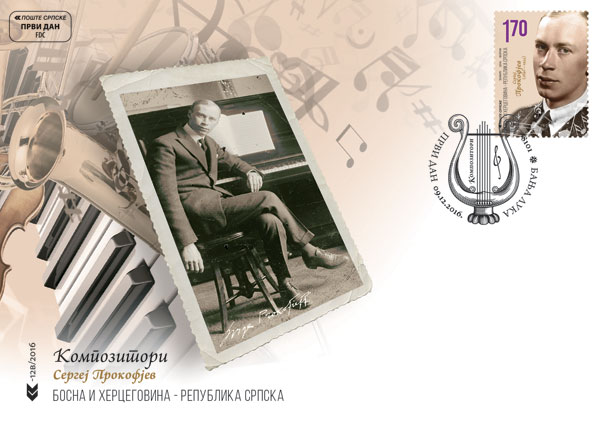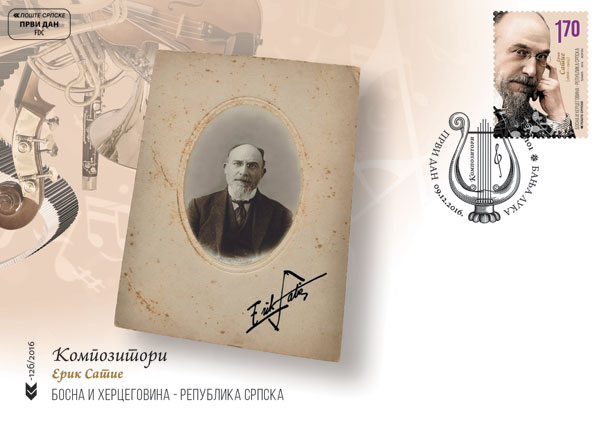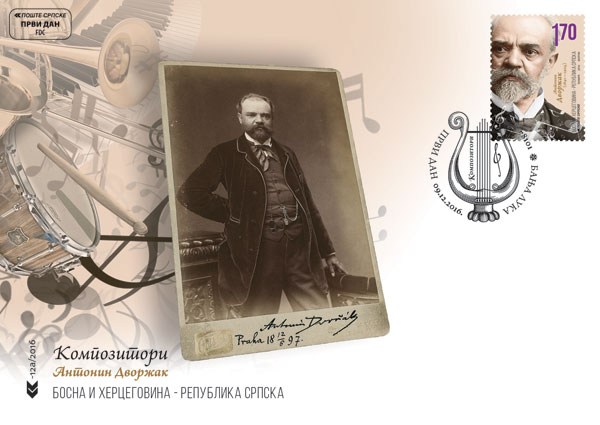Composers
Title::Composers
Date of Issue:09.12.2016.
Author:Nebojsa Djumic
Type edition:commemorative
Printing techniques:multicolour offset
Sheet:12+4
Paper:muflep 100g
Printing House:Forum, Novi Sad
 Motive:Sergei Prokofiev
Motive:Sergei Prokofiev
Catalogue no.:716
Perforation:13 3/4
Face value:1,70 BAM
Quantity:15 000
 Motive:Erik Satie
Motive:Erik Satie
Catalogue no.:717
Perforation:13 3/4
Face value:1,70 BAM
Quantity:1
 Motive:Antonin Dvorak
Motive:Antonin Dvorak
Catalogue no.:718
Perforation:13 3/4
Face value:1,70 BAM
Quantity:15 000

Sergei Prokofievbegan composing when he was ten. He was taught the music by his mother. In 1904 he began studies at the St. Petersburg Conservatory. He studied piano, composition and instrumentation (the professor was Nikolai Rimsky-Korsakov). During his studies, he composed works that brought him critical acclaim as a result of an innovative approach. From 1913 - 1915, Prokofiev traveled around France, England, Rome and Switzerland, and then across Siberia to Japan and the United States.
After the outbreak of the October Revolution, he lived in exile (1918 - 1932) - Paris, USA and Germany. During this period he composed the opera The Love for Three oranges (1919), Fiery Angel (1927), ballets Prodigal Son (1928), On the Dnieper (1930) Symphonies 2, 3 and 4. He has worked in Paris with Russian ballet. He has performed as a pianist throughout Europe, and in 1932 he returned to Russia.
He composed his most famous ballet in 1935 Romeo and Juliet. In the era of the Second World War he collaborated with Sergei Eisenstein on films Alexander Nevsky and Ivan the Terrible. Then he created one of his best works, the Sixth Symphony es-moll. After the war, the authorities were suspicious and critical of the Prokofiev, so he mostly withdrew from public life. He died in Moscow in 1953.
Author: Nebojsa Djumic
Publisher: Poste Srpske a.d. Banjaluka

Erik Alfred Leslie Satie (1866 -1925) was a French composer, pianist and writer.
He started with composing in 1887, and later in 1888 he will write his most famous works "Gimnopedies" (Gymnopédies, three compositions for piano). For himself he was telling that he is phonometrician (someone who measures sounds), not a musician. This attitude has taken as they called it "clumsy but subtle technician" in a book about modern French composers from in 1911.
In addition to composing work, Satie wrote for numerous newspapers, of Dadaist magazine 391 to the American Vanity fair. Looks like at the end of the 1880s he wrote articles under the pseudonym Virgin Lebo, although later in life he claimed to always signed the same name.
Satie was an exceptional figure in the Parisian avant-garde of the early 20th century. His work was a precursor of later musical trends of minimalism, the music that is repeated and the theater of the absurd.
Author: Nebojsa Djumic
Publisher: Poste Srpske a.d. Banjaluka

Antonin Dvorak (1841 -1904) was a Czech composer of romantic music. He has successfully combined folk music with symphonic and chamber music.
He was born in the Habsburg Monarchy, the area of today's Czech Republic, near the Czech capital, Prague, where he spent his entire life except for the period between 1892 and 1895 when he was director of the conservatory in New York.
Antonin Dvorak's next to Bedrich Smetana most important representative of Czech folk music. It is usually used for their melodies Czech National folklore, but he also used the national folklore of other Slovenian nation, and the nation of North America. He was a versatile composer: he created a symphony (the best known is in E mol "New World Symphony" was created in 1893), opera, symphonic poems, songs, overtures, orchestral, chamber music and concerts.
Antonin Dvorak was a follower of neo-Romanticism. Together with Smetana he was one of the architects of the Czech national school.
Author: Nebojsa Djumic
Publisher: Poste Srpske a.d. Banjaluka
 1371
1371  kontakt@postesrpske.com
kontakt@postesrpske.com


